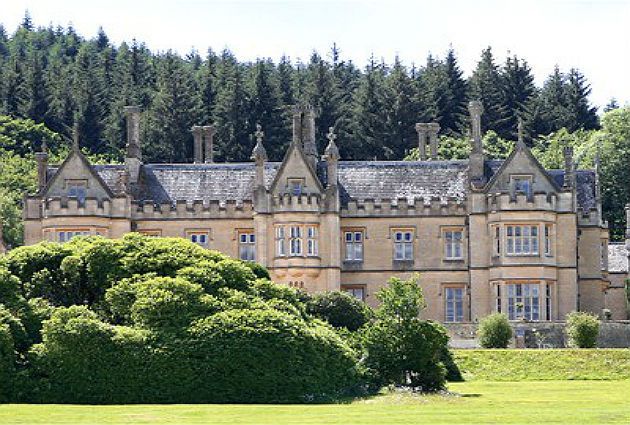Country estate in Devon for sale
Mamhead House is one of the grandest and best preserved country houses in the Haldon Hills between Exeter and Dawlish


Historically, the eight mile range of the Haldon Hills between Exeter and the coastal town of Dawlish has been both a barrier to transport and a commanding position from which to control the surrounding countryside. Over the years, the privacy and protection afforded by this picturesque landscape led some of Devon's most important families to create large landed estates in the foothills around Haldon, where, from the 18th century onwards, an increasingly prosperous local gentry imported architects and designers such as Adam, Nash, Brown and Repton to create grand new country houses and gardens.
One of the grandest and best-preserved of these ‘new' country mansions is Grade I-listed Mamhead House, which sits in 164 acres of gardens, park and woodland on the south-eastern spur of the Haldon Hills, looking east towards Powderham Castle and the Exe estuary, and bounded to the north by some 3,500 acres of Forestry Commission woodland. Currently for sale through Strutt & Parker (01392 215631) at a guide price of £8 million, the Mamhead estate dates from Domesday, when it was held by Ralph de Pomerai and later by Sir Hugh Peverell.
In the early 14th century, Sir Nicholas Carew became lord of the manor through his marriage to Amicia de Peverell, and Mamhead remained with the Carews until 1547, when Sir Peter Carew sold the estate to Giles Ball. Ball's son, or possibly grandson, Peter, was attorney to Queen Henrietta Maria, represented Tiverton from 1628 to 1640, and was compensated for his losses in the Civil War by a baronetcy. Peter Ball's grandson, Thomas Ball, who inherited some time around 1718, was a merchant who brought back numerous exotic trees from his European travels, and was the first to plant extensively on the hill behind the main house. In 1743, he also erected Mamhead's landmark 100ft-high obelisk on its summit as an aid to seafarers approaching the estuary.
Mamhead then passed to the Earls of Lisburne, before being sold by the 3rd Earl to Robert W. Newman, MP for Exeter, in 1822. Newman's family had been prosperous merchant ‘adventurers' in Dartmouth since Elizabethan times, and had long been associated with the West Country's profitable Newfoundland fishery. In 1828, Newman commissioned architect Anthony Salvin, a pupil of John Nash, to design a new house based on an earlier Classical plan drawn up by Charles Fowler of Plymouth. The old house was pulled down as soon as the new one was finished, in about 1830.
Mamhead was Salvin's first major commission, and according to Christopher Hussey (Country Life, May 26 and June 2, 1955), ‘his earliest outstanding work', which combines the symmetry of Classical design with the Tudor Gothic romanticism of the late-Georgian period. Salvin certainly earned his fee, as he designed not only the 37,000sq ft main house and numerous items of furniture, but also the red sandstone Mamhead Castle behind it. Thought to be a copy of 14th-century Belsay Castle in Northumberland, it was originally conceived as the stables, coach house and brewery, now converted to six office suites and let to yield a useful annual income of some £100,000.
The various garden structures in the terraced gardens surrounding the mansion were also designed by Salvin, and the original 18th-century gardens and park were designed by Capability Brown for the Earls of Lisburne. The stained-glass windows of the gallery and staircase were the work of Thomas Willement, heraldic expert to George IV, who was, somewhat surprisingly, also responsible for the plumbing. By the time Christopher Hussey visited Mamhead in 1955, the estate was owned by Sir Ralph Newman, a great-grandson of the 1st Baronet.
He found the mansion too big to live in, so it was let for a time and then sold, becoming first a small boarding school for boys, then a corporate headquarters, before being reinstated as a private family home by the current owner. Some 56 years later, despite a skilful overhaul throughout, the interior of the house as described by Hussey and illustrated in Country Life, is virtually identical in every major respect to Salvin's original. At the same time, rooms such as the kitchen, bathrooms, ‘minor' reception rooms and main bedrooms have all been upgraded to modern standards of comfort.
Sign up for the Country Life Newsletter
Exquisite houses, the beauty of Nature, and how to get the most from your life, straight to your inbox.
Recipients of Strutt & Parker's sumptuous sales particulars will instantly recognise the rooms and spaces described by Hussey, such as the magnificent fan-vaulted staircase hall, based on the entrance to Christ Church hall, Oxford; the dining room, with its ‘red and buff patterned wallpaper and remarkable painted chimney-piece'; and the drawing room ‘where, again, strong colour is the keynote' with ‘the elegant strap-work of the ceiling, coloured pale blue, pink and gilt' and ‘walls panelled with dark blue and gold damask'.
The adjoining library and the small breakfast room (now the music room) beyond it, are ‘pleasantly cosy, pre-dominantly the colour of the light oak bookcases, [with] Salvin's ingeniously designed Gothic ceiling grained to match'. Mamhead has five main reception rooms, five secondary reception rooms, a spacious kitchen/breakfast room, a butler's pantry, various domestic offices and extensive cellars.
Upstairs, the galleried landing leads to a number of well-proportioned bedrooms, including the Queen Adelaide room (she was a frequent visitor to Mamhead), with its adjoining dressing room and bathroom, and the William III bedroom. In addition, there are 14 first-floor bedrooms and seven bath-rooms, with the second floor, which was once the servants' quarters, comprising 11 attic rooms and two bathrooms.
Selling agent Robin Thomas is enthusiastic about the prospects for ‘one of Devon's most important houses in what can only be described as "mint condition", which sits tucked away in the beautiful Haldon Hills, totally private and unseen from anywhere, yet highly accessible from Exeter, 10 miles to the north, with London less than three hours' drive away'.
* Country Houses for sale in Devon
* Follow us on Twitter
Country Life is unlike any other magazine: the only glossy weekly on the newsstand and the only magazine that has been guest-edited by HRH The King not once, but twice. It is a celebration of modern rural life and all its diverse joys and pleasures — that was first published in Queen Victoria's Diamond Jubilee year. Our eclectic mixture of witty and informative content — from the most up-to-date property news and commentary and a coveted glimpse inside some of the UK's best houses and gardens, to gardening, the arts and interior design, written by experts in their field — still cannot be found in print or online, anywhere else.
-
 From California to Cornwall: How surfing became a cornerstone of Cornish culture
From California to Cornwall: How surfing became a cornerstone of Cornish cultureA new exhibition at Cornwall's National Maritime Museum celebrates a century of surf culture and reveals how the country became a global leader in surf innovation and conservation.
By Emma Lavelle Published
-
 Jaecoo 7 SHS: Can you really get a luxury SUV for £35,000?
Jaecoo 7 SHS: Can you really get a luxury SUV for £35,000?The Chinese automaker Jaecoo lands on UK shores with the 7. We take it for a spin around Scotland and the north of England to see if the hype is real.
By Charlie Thomas Published

